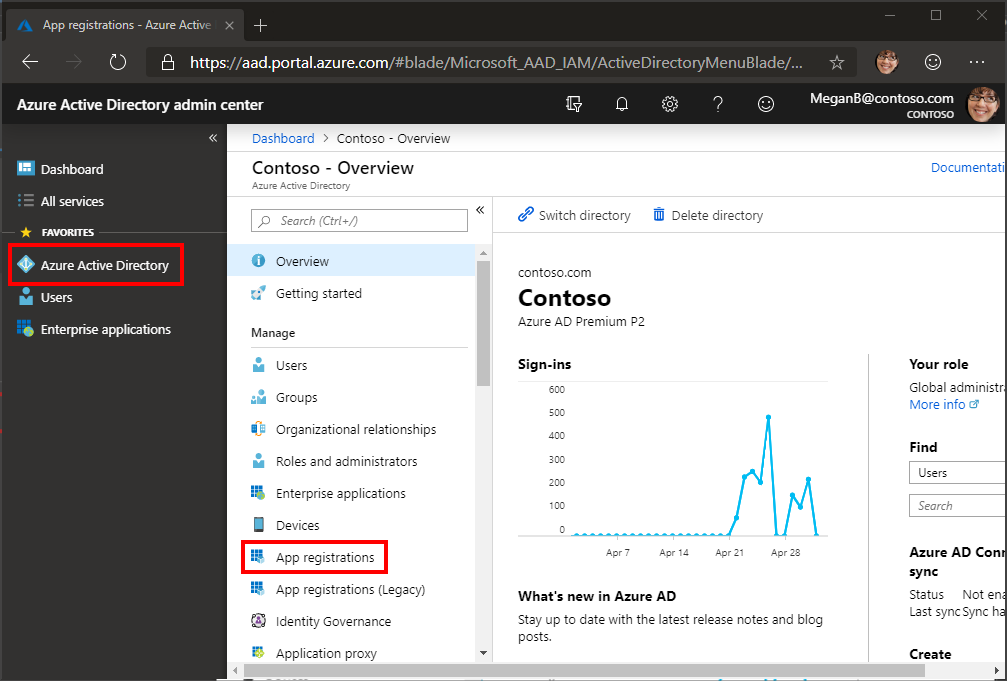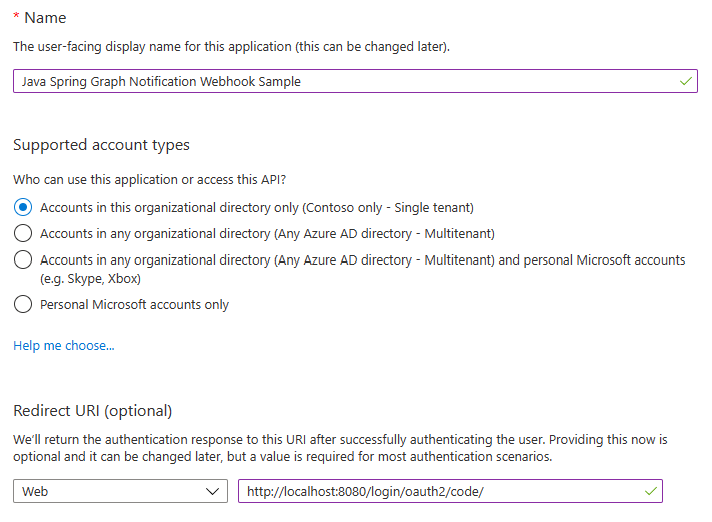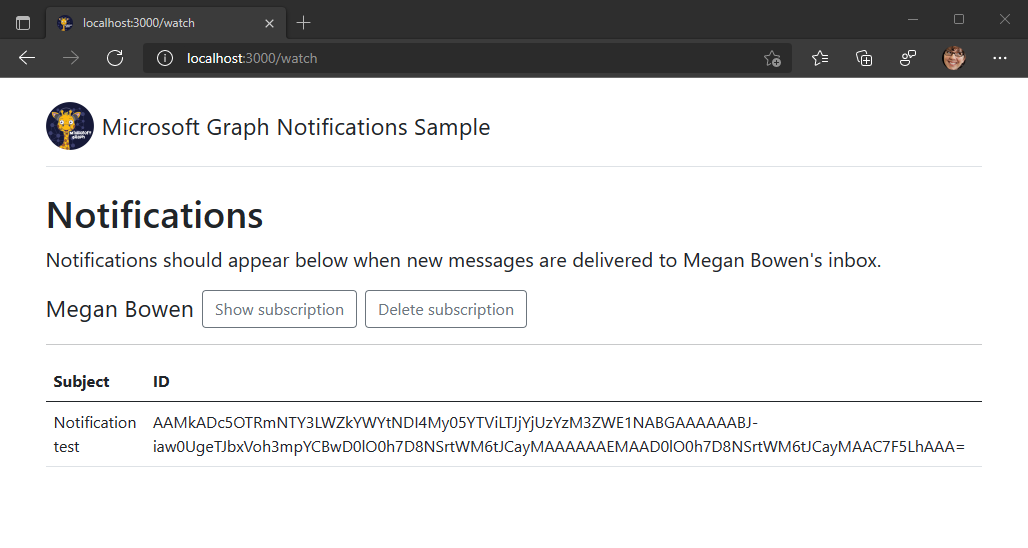Microsoft Graph Change Notifications Sample for Java Spring
Use this sample application to receive Change Notifications with Resource Data
Prerequisites
- A tenant administrator account on a Microsoft 365 tenant. You can get a development tenant for free by joining the Microsoft 365 Developer Program.
- Visual Studio Code
- ngrok.
- JDK21
- Maven.
How the sample application works
The sample has the following features:
- The user can sign in with their Microsoft 365 work account and subscribe to notifications on their Exchange Online inbox. This demonstrates how to use delegated authentication to subscribe for change notifications on a user's behalf.
- The user can subscribe to notifications for all new Teams channel messages. This demonstrates how to use app-only authentication to subscribe for change notifications, and how to create a subscription that includes resource data.
- Received notifications are displayed in the app.
Setting up the sample
- Register a Microsoft Identity platform application, and give it the right permissions.
- Update application.yml with information from the previous step
Register a Microsoft Identity platform application
Choose the tenant where you want to create your app
- Sign in to the Azure Active Directory admin center using either a work or school account.
- If your account is present in more than one Azure AD tenant:
- Select your profile from the menu on the top right corner of the page, and then Switch directory.
- Change your session to the Azure AD tenant where you want to create your application.
Register the app
Select Azure Active Directory in the left-hand navigation, then select App registrations under Manage.

Select New registration. On the Register an application page, set the values as follows.
- Set Name to
Java Spring Graph Notification Webhook Sample. - Set Supported account types to Accounts in this organizational directory only.
- Under Redirect URI, set the first drop-down to
Weband set the value tohttp://localhost:8080/login/oauth2/code/.

- Set Name to
Select Register to create the app. On the app's Overview page, copy the value of the Application (client) ID and Directory (tenant) ID and save them for later.
Select Certificates & secrets under Manage. Select the New client secret button. Enter a value in Description and select one of the options for Expires and select Add.
Copy the Value of the new secret before you leave this page. It will never be displayed again. Save the value for later.

Select API permissions under Manage.
In the list of pages for the app, select API permissions, then select Add a permission.
Make sure that the Microsoft APIs tab is selected, then select Microsoft Graph.
Select Application permissions, then find and enable the ChannelMessage.Read.All permission. Select Add permissions to add the enabled permission.
Note: To create subscriptions for other resources you need to select different permissions as documented here
In the Configured permissions list, select the ellipses (
...) in the User.Read row, and select Remove permission. The User.Read permission will be requested dynamically as part of the user sign-in process.
Select Grant admin consent for
name of your organizationand Yes. This grants consent to the permissions of the application registration you just created to the current organization.
Generate the self-signed certificate
This step is required for the app-only Teams channel message subscription. Because this subscription requests notification with resource data, Microsoft Graph will encrypt the payload. As the payload is encrypted, it requires a certificate to ensure only you will be able to decrypt the payload. To generate a self-signed certificate run the following command from the sample folder. After running the command a file named JKSkeystore.jks should appear at the root of the repository.
keytool -genkey -keyalg RSA -alias selfsignedjks -keystore JKSkeystore.jks -validity 365 -keysize 2048
Note: this command will request a password to protect the keystore, write it down, you'll need it later.
Update application.yml
Rename the application.example.yml file to
application.yml. Open the file in Visual Studio code or any text editor.Update the following values.
tenant-id: set to the tenant ID from your app registrationclient-id: set to the client ID from your app registrationclient-secret: set to the client secret from your app registrationstorepass: set to the password for your keystore
Set up the ngrok proxy (optional)
You must expose a public HTTPS endpoint to create a subscription and receive notifications from Microsoft Graph. While testing, you can use ngrok to temporarily allow messages from Microsoft Graph to tunnel to a localhost port on your computer.
You can use the ngrok web interface http://127.0.0.1:4040 to inspect the HTTP traffic that passes through the tunnel. To download and learn more about using ngrok, see the ngrok website.
Run the following command in your command-line interface (CLI) to start an ngrok session.
ngrok http 8080Copy the HTTPS URL that's shown in the console.

IMPORTANT: Keep the console open while testing. If you close it, the tunnel also closes and you'll need to generate a new URL and update the sample. See troubleshooting for more information about using tunnels.
Update
hostinapplication.ymlwith the URL.
Start the application
Open the repository with Visual Studio Code. Press F5.
Alternatively if you are not using Visual Studio Code, from the root of the repository:
mvn install
mvn package
java -jar target/graphwebhook-0.0.1-SNAPSHOT.jar
Use the app to create a subscription
Use delegated authentication to subscribe to a user's inbox
Choose the Sign in and subscribe button and sign in with a work or school account.
Review and consent to the requested permissions. The subscription is created and you are redirected to a page displaying any notification being received.
Send an email to yourself. A notification appears showing the subject and message ID.

Use app-only authentication to subscribe to Teams channel messages
If you previously subscribed to a user's inbox, choose the Delete subscription button to return to the home page.
Choose the Subscribe button. The subscription is created and you are redirected to a page displaying any notification being received.
Post a message to a channel in any team in Microsoft Teams. A notification appears showing the sender's name and the message.

Troubleshooting
See the dedicated troubleshooting page.
Contributing
If you'd like to contribute to this sample, see CONTRIBUTING.MD.
This project has adopted the Microsoft Open Source Code of Conduct. For more information see the Code of Conduct FAQ or contact opencode@microsoft.com with any additional questions or comments.
Questions and comments
We'd love to get your feedback about the Microsoft Graph Webhooks sample for Java Spring. You can send your questions and suggestions to us in the Issues section of this repository.
Questions about Microsoft Graph in general should be posted to Microsoft Q&A. Make sure that your questions or comments are tagged with the relevant Microsoft Graph tag.